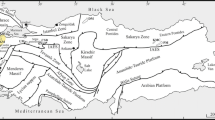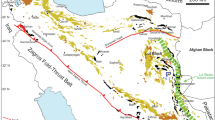Summary
Vesuvius and Stromboli are two active and extensively studied volcanoes that traditionally have been considered as having different styles of eruption, rock composition and tectonic setting. Data reveal close compositional affinities between these two volcanoes. The abundant 13–15 Ka old Stromboli leucite-tephritic rocks have radiogenic isotope signatures, and abundances and ratios of incompatible elements with the exception of Rb and K, which are identical to those of Vesuvius. The Phlegraean Fields also show close affinities to these volcanoes.
The similarity between Stromboli leucite-tephrites and Vesuvius rocks cannot be the result of low pressure processes, given the differences between the two volcanoes in terms of structural features, eruptive behaviour and type of basement rocks. Instead, the observed geochemical signatures are likely to represent a primary magma composition and reveal a common homogeneous source for the two suites. The higher K and Rb contents in the Vesuvius rocks suggest either selective enrichment during magma ascent or a role for phlogopite melting during mantle anatexis.
The most primitive rocks from Vesuvius, Phlegraean Fields and Stromboli reveal intermediate compositions between arc and intraplate volcanics. It is suggested that the mantle sources beneath these volcanoes consist of a mixture of intraplate- and slab-derived components. Intraplate material was probably provided by inflow of asthenosheric mantle into the wedge above the subducting Ionian Sea plate, either from the Apulian plate and/or from the Tyrrhenian Sea region. Fluids or melts released from the sinking slab and associated sediments generated metasomatic modification of the intraplate material, whose melting gave rise to the Stromboli, Vesuvius and Phlegraean Fields magmas.
The present study demonstrates how comparative investigations of various volcanic centres from southern Italy allow clarification of a number of problems involving magma genesis and evolution, composition of mantle sources and geodynamic significance, which have been long debated and are difficult to solve if individual volcanoes are considered in isolation.
Similar content being viewed by others
Author information
Authors and Affiliations
Additional information
Received July 20, 2000; revised version accepted March 19, 2001
Rights and permissions
About this article
Cite this article
Peccerillo, A. Geochemical similarities between the Vesuvius, Phlegraean Fields and Stromboli Volcanoes: petrogenetic, geodynamic and volcanological implications. Mineralogy and Petrology 73, 93–105 (2001). https://doi.org/10.1007/s007100170012
Issue Date:
DOI: https://doi.org/10.1007/s007100170012




